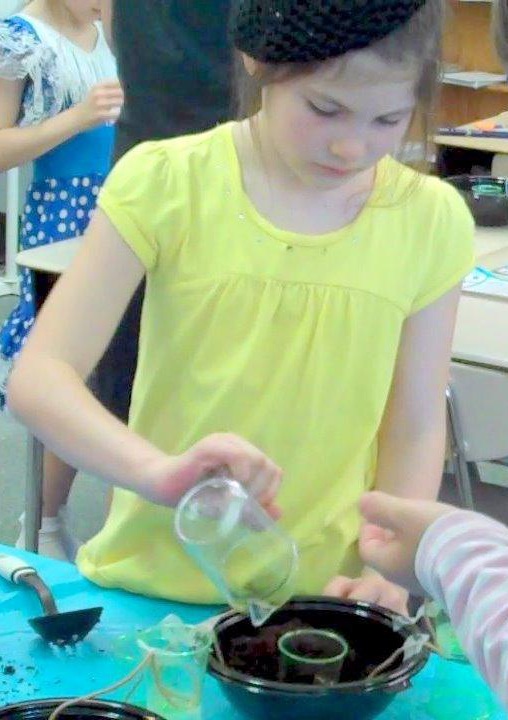Home > Programs > After-school classes > Eco-KID
Packed with Big Learning: Each week students learn new techniques for designing and building living models and simulations of habitats and ecosystems. Students replicate natural mechanisms including water cycle processes, habitat design, and plant and animal life cycles. With materials that are easy to work with and tools that are safe for kids, your young ecologist can construct amazing living projects.
No "cookie cutter" projects: Every task engages children's creative energy. Every child's project is unique. Design choices pull kids into the learning experience.

Supports school and life success: Every project pulls together wideranging knowledge and skills. In the Nesting Cache project, students practice measurement skills while learning about materials birds use to build nests; they use 3-D geometric shapes to
Most importantly, every session builds life skills including problem solving, persistence, creativity, artistic competence, communication, and teamwork.
Highly engaging: Kids can't resist our combination of real-world learning and design-based curriculum. Every task engages children's creative energy, and every child's project is unique.
Students use various materials such as wire, soil, and seeds to recreate or support existing habitats and ecosystems. For instance, in the brine shrimp project, students design habitats and raise live brine shrimp. Students see the relevance of new knowledge because they put it to work immediately.
Full-color posters, student instructions, and take home sheets make for lessons that stick.
Eco-KID
Eco-KID is an 8-session series in Big Learning's KID (Knowledge-Infused Design) after-school curriculum. It's designed for children in grades 2 through 4.Overview
Packed with Big Learning: Each week students learn new techniques for designing and building living models and simulations of habitats and ecosystems. Students replicate natural mechanisms including water cycle processes, habitat design, and plant and animal life cycles. With materials that are easy to work with and tools that are safe for kids, your young ecologist can construct amazing living projects.
No "cookie cutter" projects: Every task engages children's creative energy. Every child's project is unique. Design choices pull kids into the learning experience.
Typical Projects
| Session | What we make | Feature career | Big Learning |
|---|---|---|---|
| 1 | Nesting Cache | Conversation Planner | Habitat requiements for native species, measuring in inches, spirals and spheres, combining function with beauty. |
| 2 | Grass-scapes | Landscape Architect | Germination process, measuring in tablespoons and cups, combining function with beauty |
| 3 | Air Plants | Botanist | Adaptation, create structures using wire to support air plants and replicate the rainforest environment to which they are uniquely adapted. |
| 4 | Wick-Fed Farms | Agronomist | Water cycle processes, use of water by humans in agriculture, visualizing the Ecosystem at work by channeling water through soil with yarn. |
| 5 | Extinction Board Game | Evolutionary Biologist | Evolution, natural selection, adaptation to environment, traits that lead to extinction, creating number lines to help add, subtract, multiply, and divide large numbers. |
| 6 | Brine Shrimp Habitat | Microbiologist | Life cycle stages, creating environmental conditions of high salinity, measuring in tablespoons and cups. |
| 7 | Harvest Board Game | Wildlife Manager | Harvesting natural resources in a sustainable manner, using probability, rules for use of common resources. |
| 8 | Field Kit | Field Biologist | Ecosystems, biodiversity, measuring area in square feet, using samples to represent populations. |
Features

A student pours soil into
her wick-fed farm project
her wick-fed farm project
My daughter LOVED the ECO-Kid class. The tactile, hands-on curriculum provides a wonderful way for children to learn about the natural sciences. I regularly witnessed the kids fully engrossed in the projects in front of them. The take-home projects are proudly displayed in our home and continue to give my daughter rewarding opportunities for observation. This is a fantastic class! - Laura J.
design objects that are both functional and beautiful; and they learn some of the habitat elements required for native bird species to live and grow.Most importantly, every session builds life skills including problem solving, persistence, creativity, artistic competence, communication, and teamwork.
Highly engaging: Kids can't resist our combination of real-world learning and design-based curriculum. Every task engages children's creative energy, and every child's project is unique.
Students use various materials such as wire, soil, and seeds to recreate or support existing habitats and ecosystems. For instance, in the brine shrimp project, students design habitats and raise live brine shrimp. Students see the relevance of new knowledge because they put it to work immediately.
Full-color posters, student instructions, and take home sheets make for lessons that stick.


